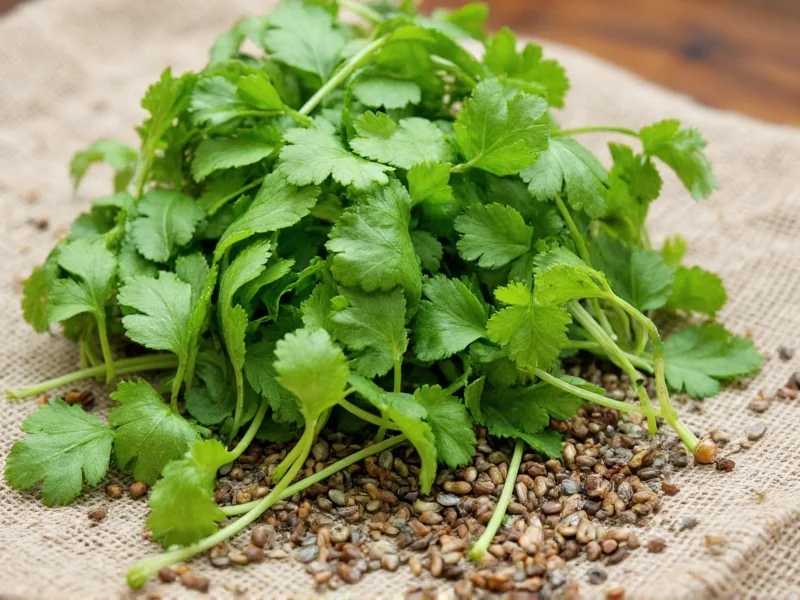Understanding the proper conversion between fresh and dried cilantro prevents recipe failures and wasted ingredients. Many home cooks mistakenly use equal measurements when substituting, resulting in dishes that are either bland or overpowering. The 3:1 ratio accounts for the significant moisture difference between fresh and dried herbs.
Why Fresh and Dried Cilantro Aren't Interchangeable
Cilantro's transformation from fresh to dried involves complex chemical changes. Fresh cilantro contains approximately 92% water, while dried cilantro drops to about 10% moisture content. This dehydration concentrates certain compounds while diminishing others. The volatile oils responsible for cilantro's distinctive citrus aroma partially evaporate during drying, resulting in a more earthy, muted flavor profile.
When substituting dried for fresh cilantro in recipes, consider the dish's cooking time. Add dried cilantro early in the cooking process to allow rehydration and flavor distribution. For fresh cilantro's bright notes, add it at the very end of cooking or as a garnish.
Effective Methods for Drying Fresh Cilantro
Proper drying technique significantly impacts the final flavor and shelf life of your dried cilantro. Three reliable methods yield excellent results:
1. Air Drying (Traditional Method)
Bundle cilantro stems together with twine and hang upside down in a dark, well-ventilated space with temperatures between 60-70°F (15-21°C). Complete drying takes 1-2 weeks. This slow method preserves more flavor compounds than faster techniques. Cover the bundles with a paper bag with holes punched for airflow to prevent dust accumulation.
2. Oven Drying (Faster Alternative)
Spread cilantro leaves in a single layer on a baking sheet. Set your oven to its lowest temperature (ideally 170°F/77°C or lower). Prop the oven door open slightly to allow moisture escape. Check every 15-20 minutes until completely dry and crumbly (typically 1-3 hours). Oven drying risks flavor loss if temperatures exceed 180°F (82°C).
3. Dehydrator Method (Most Consistent Results)
Arrange cilantro leaves on dehydrator trays without overlapping. Set temperature to 95°F (35°C) and dry for 2-4 hours. The controlled environment preserves maximum flavor while ensuring complete moisture removal. This method produces the most consistent results for serious home cooks.
Proper Storage for Maximum Shelf Life
Store dried cilantro in airtight glass containers away from light, heat, and moisture. Properly stored dried cilantro maintains optimal flavor for 6-12 months. Exposure to humidity causes clumping and flavor degradation. For extended shelf life, store in the freezer where dried herbs can maintain quality for up to 2 years.
Always label containers with the drying date. Over time, dried cilantro loses potency. Discard if the herb no longer emits a strong aroma when crushed between your fingers. Properly stored dried cilantro should retain a vibrant green color; significant browning indicates flavor deterioration.
| Measurement (Fresh Cilantro) | Equivalent Dried Cilantro | Best Usage Context |
|---|---|---|
| 1 teaspoon fresh | ⅓ teaspoon dried | Finishing touches on soups or sauces |
| 1 tablespoon fresh | 1 teaspoon dried | Standard recipe substitutions |
| ¼ cup fresh | 1½ tablespoons dried | Cooking applications requiring longer simmering |
| ½ cup fresh | 3 tablespoons dried | Stews, curries, and slow-cooked dishes |
| 1 cup fresh | ⅓ cup dried | Batch cooking or preserving for future use |
When to Choose Fresh vs. Dried Cilantro
Culinary applications determine whether fresh or dried cilantro serves best. Fresh cilantro shines in dishes where its bright, citrusy notes enhance the final presentation: salsas, guacamole, ceviche, and as a garnish for finished dishes. The delicate flavor compounds dissipate quickly with heat exposure.
Dried cilantro works better in long-cooked dishes where fresh would lose its character: stews, chili, spice rubs, and marinades. The concentrated flavor withstands extended cooking times. For Mexican and Indian cuisines requiring deep, earthy cilantro notes, dried often provides more authentic flavor than fresh in cooked applications.
Avoiding Common Cilantro Substitution Mistakes
Many cooks make critical errors when substituting dried for fresh cilantro. The most frequent mistake involves using equal measurements rather than adjusting for concentration. Using 1:1 substitution typically results in overpowering, bitter flavors.
Another common error involves adding dried cilantro too late in the cooking process. Unlike fresh cilantro, which loses flavor with prolonged heat, dried cilantro requires time to rehydrate and release its oils. Add dried cilantro during the early cooking stages, allowing at least 15-20 minutes for proper flavor integration.
Don't confuse cilantro with coriander seed. While both come from the same plant (Coriandrum sativum), they have distinctly different flavor profiles. Cilantro refers to the fresh leaves, while coriander typically refers to the dried seeds, which have a warm, citrusy, slightly nutty flavor.
Maximizing Flavor in Your Dried Cilantro
Revive dried cilantro's flavor by toasting it lightly in a dry skillet over medium heat for 30-60 seconds before use. This simple technique releases additional aromatic compounds. Alternatively, reconstitute dried cilantro by soaking in warm water or broth for 10-15 minutes before adding to recipes.
For recipes requiring fresh cilantro's texture, consider combining dried cilantro with fresh parsley or other herbs to approximate the visual and textural elements while maintaining the flavor profile. This hybrid approach works well in dishes like tabbouleh or herb salads where appearance matters.











 浙公网安备
33010002000092号
浙公网安备
33010002000092号 浙B2-20120091-4
浙B2-20120091-4